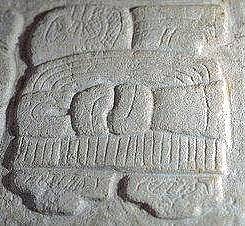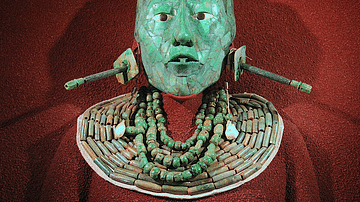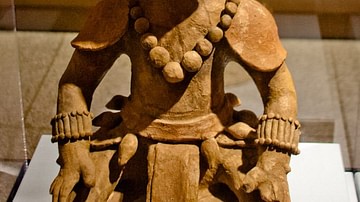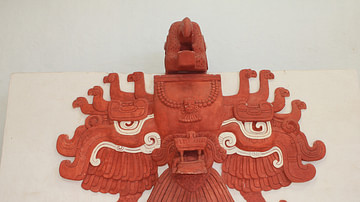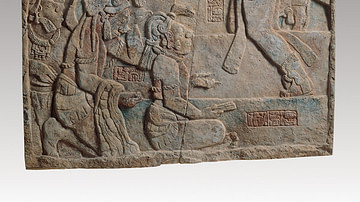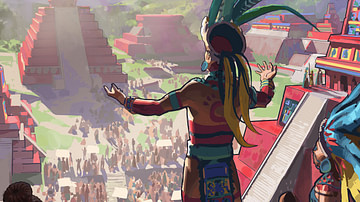The Maya hieroglyphic writing system was a sophisticated combination of pictographs directly representing objects and ideograms (glyphs) expressing more abstract concepts such as actions, ideas and syllabic sounds. Maya writing has survived on stone carvings, stucco, various manufactured artefacts, and codices. Examples are found across Mesoamerica. Deciphered in the 20th century, around 75% of surviving texts can be understood.
Origins
The hieroglyphic writing system of the Maya may have developed from the less sophisticated systems of earlier Mesoamerican civilizations, such as the Olmec, which used only literal images (pictographs) or it may have developed completely independently; scholars are not in agreement on the point. More certain is when the Maya began their writing system: the second half of the Middle Preclassic period, c. 300 BCE. However, the more sophisticated writing system of this time almost certainly would have had earlier, less complex precedents present in the preceding centuries of Mayan culture. From the Early Classic period onwards there was a significant increase in stone monuments bearing inscriptions and the language reached full maturity and flourished throughout the Classic period (250-900 CE).
Sources
The best-preserved examples of Maya writing are often from stone monuments, most commonly altars, stelae and elements of architectural sculpture, especially around doorways and stairs. Pottery is another important source of script as vessels often carry either painted or inscribed writing. Examples of painted writing, although much rarer, also survive in caves and on some interior walls of buildings. Another source, albeit with shorter examples of text, are inscribed artefacts made from jade, greenstone, shell, and bone. Finally, there are written books. These screen-fold volumes written on bark paper had always been in use and, from the 9th century CE, they became the preferred medium for Mayan writers as inscriptions on monuments all but disappeared. Unfortunately for posterity, only three examples have survived the ravages of a tropical climate and zealous spanish priests, and these all date from the late Postclassic period. The three surviving codices - interestingly, written using only black and red ink - are currently housed in museums in Paris, Madrid and Dresden. A few pages from a fourth Mayan text also survive and are housed in the National Museum of Anthropology in Mexico City.
The System
The meaning of a given text has to be interpreted from a triple combination of images which literally represent real objects or actions (pictographs); symbols (glyphs) which symbolically refer to objects or actions (and which can also indicate adjectives, prepositions, plurals, and numbers); and phonetic glyphs which represent sounds (for example a vowel or a consonant and a vowel together), correct pronunciation, pre-fixes, suffixes, pronouns and tense. The Mayan script is, therefore, a combination of signs representing syllables (syllabograms) and words (logograms). Sometimes, concepts could be represented in alternative ways, for example, a jaguar could be indicated by a picture of a jaguar head or by the phonetic glyphs ba-la-ma or by a combination of a jaguar head and the glyph ma.
Although there are around 1,000 different symbols in the Maya script, scribes of any one period used a range of between 300 to 500 signs. Despite the fact that there are only five vowels and nineteen consonants in the Maya language, there are actually 200 syllabic signs. This is because combinations of vowels and consonants could be indicated and a single sound could also be represented by several different signs. In addition, the language evolved over time to produce symbols more aesthetically pleasing for certain inscriptions and innovations could combine, or reduce by simplification, older symbols which made the signs more and more abstract. However, symbols representing whole words always remained more common than syllable symbols, a fact perhaps explained by the Mayan reverence for tradition, the sacred nature of language, and the desire to make the text as accessible as possible to all readers.
Signs and symbols were arranged in blocks which were placed in double columns. The text is read by starting from the top left and reading horizontally across two blocks and then moving down to the row below. In very short texts the glyph blocks are placed in a single line and are read from top to bottom in vertical texts or left to right in horizontal texts. Sentences follow the structure verb-object-subject and when necessary adverbs are placed before the verb.
Maya Literacy
It is probable that only a small elite of the Maya population could read, possibly only the nobility and priests. Interestingly, women of such status were not barred from learning to read and write. This restriction on just who acquired literacy fitted with the belief that writing was sacred. Indeed, the Maya believed that writing was invented by the god Itzamna and in the sacred text the Popol Vuh, the Monkey Scribes - the gods Hun Batz and Hun Chuen, brothers of the Hero Twins - are the patrons of writing and the arts in general. These two gods are often depicted on Maya pottery sat together with pen or brush in hand writing in a codex. Although literacy was, then, almost certainly limited, it may be that the general populace could recognise common symbols such as those representing dates and rulers.
The actual production of texts was probably limited to priestly scribes assigned to the workshops of royal palaces. The high frequency of artists' signatures on stelae, pottery and sculptures and their notable absence in written texts suggests that scribes did not enjoy the status of other artisans. Indeed, it may be that scribes were not regarded as authors but, rather, as recorders of the declarations of the gods and divine rulers. This is also indicated by the very formulaic nature of Maya writing where formalised phrases are often repeated and the fact that the most common subjects of Maya texts are histories of both the real world and mythology, texts which declare ownership of particular objects, and texts dedicating buildings and monuments to specific gods.
Legacy
The Maya system of writing would go on to influence that other great Mesoamerican civilization the Aztecs who would build upon the progress made by the Maya by incorporating even more phonetic elements into their writing. The Maya writing system continued to be used up to the Spanish Conquest but then this 'pagan' text was prohibited. Despite the deliberate destruction of Maya texts and the prohibition of the language the Maya did, though, continue to use it in secret well into the 18th century CE.

